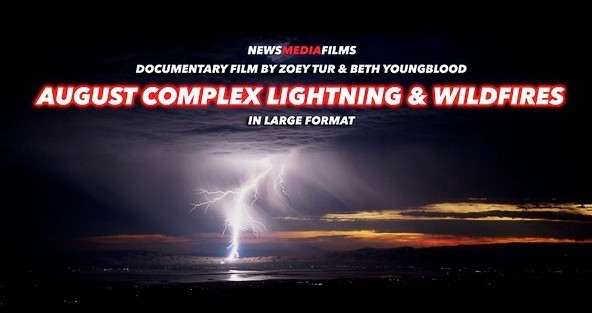California Wildfire Documentary
What if there was a wildfire so intense that it burned an area the size of Rhode Island? What if the recurrence of such an event was growing in likelihood each and every year? What would the impact be on our nation? How would our brave emergency responders be able to confront such an immense and growing threat?
This is the reality we live in today. The western U.S. has seen a steady increase in fires over the last six decades with the majority, over 60%, occurring in the past 20 years. And they’re getting bigger. Megafires (fires that burn more than 156 square miles) are becoming more frequent and larger in size. In fact, no megafires have been recorded prior to 1970 – today, they’re a common occurrence.
California in particular has been plagued with increasing frequency and severity of megafires over the last several years, a result of extreme weather conditions driven by hotter, longer droughts. Of the 20 largest fires in California’s history, 40% have occurred in the last three years alone, and none larger than the August Complex Fire – the state’s first, but certainly not last, gigafire.
In August of 2020, dealing with failures in prediction and planning and working with limited resources, our nation’s firefighters faced the largest wildfire in California history. The deadly August Complex Fire, brought on by severe lighting events, burned more than 1 million acres (over 1,600 square miles) and took four months to contain. The fire impacted thousands of people across multiple counties and national forest areas and required a combined effort from more than 3,000 people spread across local fire departments, the U.S. Forest Service, National Guard, and more.
The August Complex Lightning and Wildfires documentary (shot in large format 8k and produced by renowned cinematography, directing, and reporting team who’s captured multiple Emmy, Edward R. Murrow, Peabody, National Press Club Humanitarian, and Associated Press’ Breaking News awards) highlights the strain on our nation’s firefighting capabilities and the need to adapt to our collective new normal – more frequent and deadly severe weather.
Red Flag fire warnings had been issued for the Coast Range of Northern California throughout the month of August – dry lightning storms and gusty winds were predicted to move through the hot, drought-wrought area. It was a waiting game for fire and forest management personnel to see how much lighting the area would receive and how many fires would start. On August 16th, the waiting transitioned into a battle – a battle to contain more than 37 swiftly moving lightning-sparked fires rapidly growing in size and danger.
August 16th started out as an otherwise normal day for Zoey Tur and Beth Youngblood – a highly experienced filmmaking team producing cutting-edge documentary and feature films through their Bay Area NewsMedia Films production company. Zoey Tur, the most storied helicopter news pilot in history, is no stranger to covering breaking news and throwing herself into the middle of danger to save lives and document historical events. Zoey captured and curates one of the largest Los Angeles area News Service archives including first-hand coverage of the 1992 Los Angeles riots, live capture, and broadcast of the OJ Simpson chase, and single-handedly piloting her helicopter in high winds to save 54 lives from a partially collapsed hotel damaged in a freak storm. And Beth Youngblood, an ultra-marathon runner and research scientist who has turned her passion for adventure and technical expertise into exemplary documentary filmmaking focused on large format cinema and sound design. Together, Zoey and Beth produce rich stores of historical content that capture events most of us are unable or unwilling to attempt due to the inherent danger involved. So when Beth and Zoey heard of the outbreak of fire in the Coast Range of Northern California, they knew it was time to act. They immediately grabbed their gear and headed for the heart of the fire.
Within the first 24 hours, the fires grew to cover over a thousand acres, quickly spreading as a result of dry conditions, dead beetle-kill trees, and gusty winds that combined for devastating wildfire conditions. Throughout the remainder of August, conditions continued to deteriorate with extremely low humidity and ongoing winds. By the end of the month, the fire had grown to nearly 200,000 acres, a mega-fire that was far from over and one that had claimed its first life.
Nearly 3,000 personnel were deployed to fight the fire, under the management of the U.S. Forest Service and the California Department of Forestry and Fire Protection. A total of more than 650 individual fires had started and spread from August to November of 2020 until ultimately breaching one million acres of land, destroying over 3,500 structures, and taking 23 of our neighbor’s lives. Even with such a large contingent battling the flames, the fire took four months to contain. A combination of rugged terrain, dry conditions, and consistent high temperature and winds complicated valiant firefighting efforts.
The strain on our nation’s firefighters through inadequate resources and limited crew sizes further exacerbates the consequence of wildfires and challenges firefighting efforts. A larger better equipped attacking force would have undoubtedly helped contain the August Complex Fire more quickly. But, through grit, determination, a little good luck, and favorable weather conditions, the fire was brought under complete control by the middle of November. As evidenced by the dedication and care of our nation’s collective fire fighting personnel, rapid assessment teams began planning post-fire vegetation management even before the fire was fully contained in an effort to accelerate recovery. Their goal, is to eventually bring life and a sense of normalcy back to the devastated August Complex Fire landscape.
Now in post-fire management, restoration efforts are beginning to bear fruit and painful wounds are beginning to heal. Scars will forever remain, however, and the next threat looms in the near future. It’s not a question of if, but when the August Complex Fire will be surpassed by the next more devastating gigafire. Who’s homes and lives will be destroyed this time? How will we respond as a nation and as a society to these challenges, largely a consequence of human-driven climate change?
Science-based research shows that the trends over the last several decades are going to increase – global warming is predicted to drive higher the number of mega and Giga fires in the western U.S. with a potentially profound impact on the natural environment, human health, and economic markets. More regular thick smoke is expected to impair outdoor recreational activities, disruptions to rangelands will impact agricultural productivity reducing food security and price stability, and our nation’s aging infrastructure will be stressed even further beyond its limits. Worst of all, our nation’s firefighting capacity and capabilities will reach a breaking point. Greater action must be taken to address the causes of wildfires and to mitigate the brutal effects.
Witness the impact of wildfires for yourself through the August Complex Lightning and Wildfires* documentary and you decide – What actions can be taken to address climate change and lessen inevitable growth in severe weather? How can we focus attention on our nation’s fire prevention and fighting abilities?
*Film to be released for screening online, at theaters, and on cable TV soon.
References:
Six trends to know about fire season in the western U.S.
California Wildfire Emission Estimates
Geography of Wildfires Across the West



